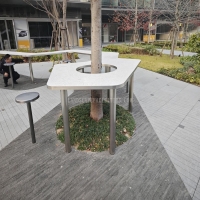Welcome to the website for landscape facilities products and knowledge.
How can a landscape bar counter be customized to match the architectural style of a home or commercial space?
A landscape bar counter serves as more than just a functional surface; it acts as a central design element that can either harmonize with or disrupt the architectural narrative of a space. Achieving a seamless integration requires a meticulous approach that considers the core principles of the existing design language. The process begins not with selecting materials, but with a deep analysis of the architectural style itself, whether it's the clean lines of Modernism, the ornate details of Victorian, the raw appeal of Industrial, or the warm minimalism of Scandinavian design.
The most critical step is deconstructing the architectural style into its fundamental components. For a modern space, this means embracing simplicity, horizontal emphasis, and a lack of ornamentation. A custom bar counter here would favor monolithic materials like quartz or polished concrete, with an integrated sink and minimalist faucet to maintain the uninterrupted flow. In contrast, a classic or traditional home demands detail. This is where custom millwork shines, incorporating paneled ends, decorative corbels, a substantial overhang for legroom, and a rich, stained wood or marble top that echoes other finishes in the room.
Material selection is the primary tool for achieving visual cohesion. The countertop and base materials should consciously reference other elements within the interior. In a rustic or farmhouse setting, reclaimed wood and honed natural stone create an authentic feel. An industrial loft space calls for concrete, sealed metals, and reclaimed lumber, perhaps even exposing structural elements of the bar itself. For a coastal style, a light bleached wood or a white quartz with subtle veining paired with a shiplap base can effortlessly capture the aesthetic.
Beyond materials, the form and layout are equally important. The bar's shape should complement the room's geometry. A long, linear "landscape" counter is ideal for reinforcing the clean lines of a contemporary open-plan area. In a more organic or free-flowing layout, a curved or L-shaped island might integrate more naturally, improving circulation and defining the space without abrupt angles.
Finally, integrating stylistic details ensures the bar feels inherent to the design, not an afterthought. This includes matching hardware finishes to other fixtures in the space, selecting appropriate bar stools that align with the era and style, and implementing lighting that serves both function and mood. Under-counter LED strips enhance a modern feel, while pendant lights with vintage bulbs are perfect for industrial or rustic themes. Ultimately, a successfully customized landscape bar counter doesn't just fit in; it feels as though it was always an intended part of the architectural blueprint, enhancing both the functionality and the aesthetic story of the home or commercial environment.
Related search:

Recommendation
An outdoor bar counter with stainless steel and terrazzo materials in an irregular shape